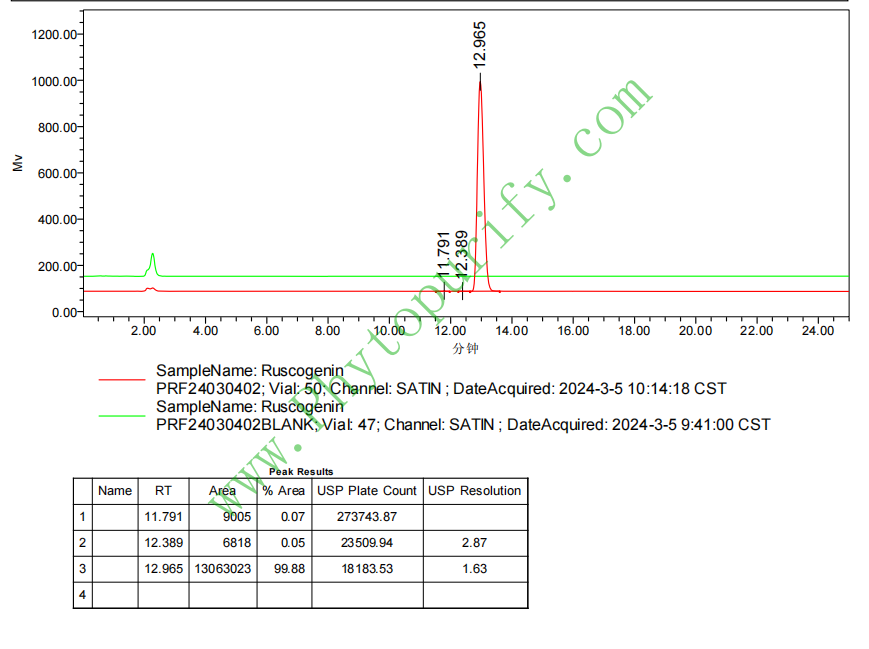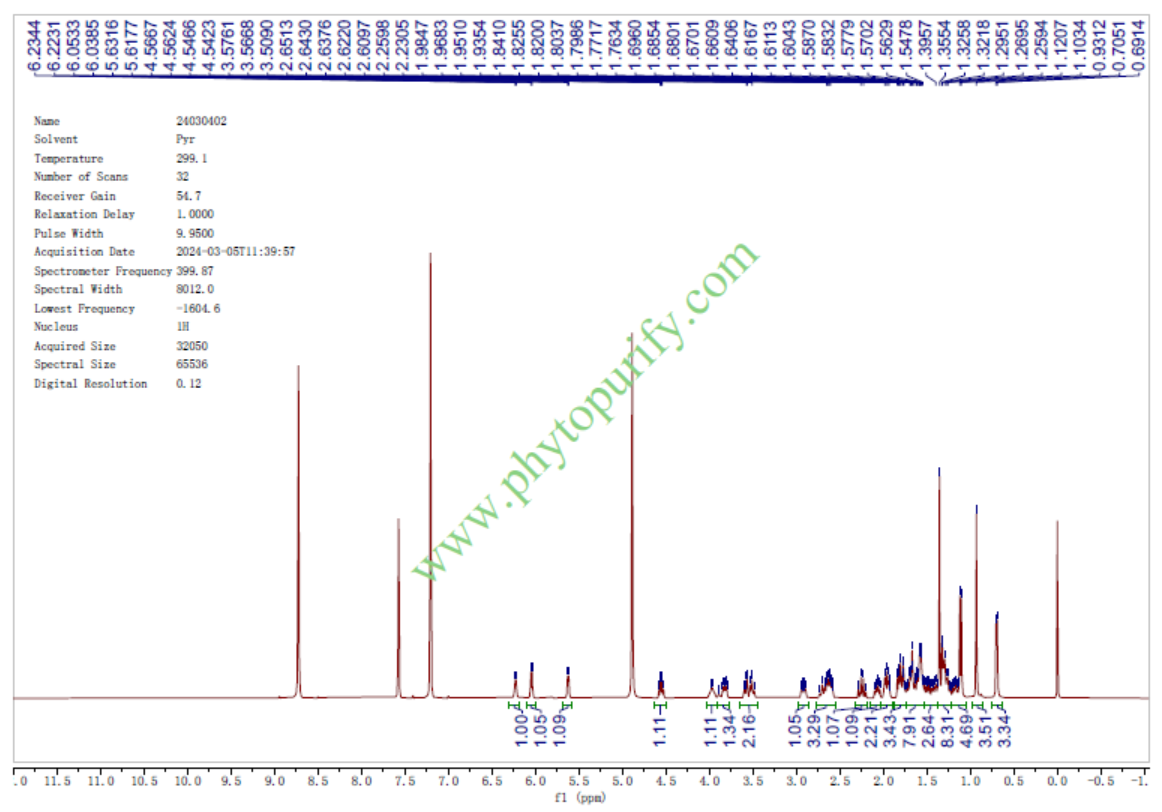
RuscogeninCAS No.:472-11-7 |
||||||||||
 |
|
|
||||||||

| Catalogue No.: | BP1231 |
| Formula: | C27H42O4 |
| Mol Weight: | 430.629 |
| Botanical Source: | Ophiopogonis Radix |
Product name: Ruscogenin
Synonym name: (25RS)-Ruscogenin; 874485-32-2
Catalogue No.: BP1231
Cas No.: 472-11-7
Formula: C27H42O4
Mol Weight: 430.629
Botanical Source: Ophiopogonis Radix
Physical Description:
Type of Compound: Steroids
Purity: 95%~99%
Analysis Method: HPLC-DAD or/and HPLC-ELSD
Identification Method: Mass, NMR
Packing: Brown vial or HDPE plastic bottle
Storage: Store in a well closed container, protected from air and light. Put into refrigerate or freeze for long term storage.
Whenever possible, you should prepare and use solutions on the same day. However, if you need to make up stock solutions in advance, we recommend that you store the solution as aliquots in tightly sealed vials at -20℃. Generally, these will be useable for up to two weeks.
The product could be supplied from milligrams to grams
Inquire for bulk scale.
Description:
Ruscogenin exerts significant anti-inflammatory and anti-thrombotic activities.Ruscogenin significantly attenuates LPS-induced acute lung injury (ALI )via inhibiting expressions of TF and iNOS and NF-κB p65 activation, it inhibits activation of neutrophil through cPLA 2 , PAK, Akt, MAPKs, cAMP, and PKA signaling pathways.
References:
J Pharmacol Sci. 2008 Oct;108(2):198-205.
Possible mechanism of the anti-inflammatory activity of ruscogenin: role of intercellular adhesion molecule-1 and nuclear factor-kappaB.
Ruscogenin (RUS), first isolated from Ruscus aculeatus, also a major steroidal sapogenin of traditional Chinese herb Radix Ophiopogon japonicus, has been found to exert significant anti-inflammatory and anti-thrombotic activities.
METHODS AND RESULTS:
Our previous studies suggested that Ruscogenin remarkably inhibited adhesion of leukocytes to a human umbilical vein endothelial cell line (ECV304) injured by tumor necrosis factor-alpha (TNF-alpha) in a concentration-dependent manner. Yet the underlying mechanisms remain unclear. In this study, the in vivo effects of Ruscogenin on leukocyte migration and celiac prostaglandin E(2) (PGE(2)) level induced by zymosan A were studied in mice. Furthermore, the effects of Ruscogenin on TNF-alpha-induced intercellular adhesion molecule-1 (ICAM-1) expression and nuclear factor-kappaB (NF-kappaB) activation were also investigated under consideration of their key roles in leukocyte recruitment. The results showed that Ruscogenin significantly suppressed zymosan A-evoked peritoneal total leukocyte migration in mice in a dose-dependent manner, while it had no obvious effect on PGE(2) content in peritoneal exudant. Ruscogenin also inhibited TNF-alpha-induced over expression of ICAM-1 both at the mRNA and protein levels and suppressed NF-kappaB activation considerably by decreasing NF-kappaB p65 translocation and DNA binding activity.
CONCLUSIONS:
These findings provide some new insights that may explain the possible molecular mechanism of Ruscogenin and Radix Ophiopogon japonicus for the inhibition of endothelial responses to cytokines during inflammatory and vascular disorders.
Biomed Res Int. 2014;2014:652680.
Ruscogenin ameliorates experimental nonalcoholic steatohepatitis via suppressing lipogenesis and inflammatory pathway.
The aim of the study was to investigate the protective effects of Ruscogenin, a major steroid sapogenin in Ophiopogon japonicus, on experimental models of nonalcoholic steatohepatitis.
METHODS AND RESULTS:
HepG2 cells were exposed to 300 μmol/l palmitic acid (PA) for 24 h with the preincubation of Ruscogenin for another 24 h. Ruscogenin (10.0 μmol/l) had inhibitory effects on PA-induced triglyceride accumulation and inflammatory markers in HepG2 cells. Male golden hamsters were randomly divided into five groups fed a normal diet, a high-fat diet (HFD), or a HFD supplemented with Ruscogenin (0.3, 1.0, or 3.0 mg/kg/day) by gavage once daily for 8 weeks. Ruscogenin alleviated dyslipidemia, liver steatosis, and necroinflammation and reversed plasma markers of metabolic syndrome in HFD-fed hamsters. Hepatic mRNA levels involved in fatty acid oxidation were increased in Ruscogenin-treated HFD-fed hamsters. Conversely, Ruscogenin decreased expression of genes involved in hepatic lipogenesis. Gene expression of inflammatory cytokines, chemoattractive mediator, nuclear transcription factor-(NF-) κB, and α-smooth muscle actin were increased in the HFD group, which were attenuated by Ruscogenin.
CONCLUSIONS:
Ruscogenin may attenuate HFD-induced steatohepatitis through downregulation of NF-κB-mediated inflammatory responses, reducing hepatic lipogenic gene expression, and upregulating proteins in β-oxidation pathway.
HPLC of Ruscogenin

HNMR of Ruscogenin
